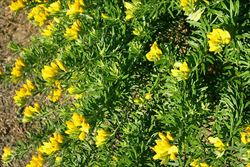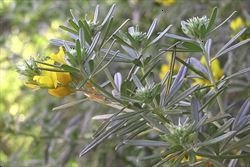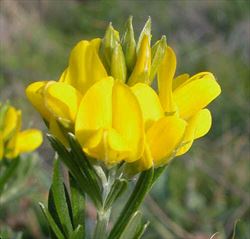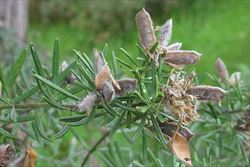Click on images to enlarge

habit (Photo: Sheldon Navie)

habit (Photo: Sheldon Navie)

leaves and flower clusters (Photo: Jackie Miles and Max Campbell)

compound leaves with three elongated leaflets (Photo: Jackie Miles and Max Campbell)

close-up of pea-shaped flowers (Photo: Greg Jordan)

close-up of stems, leaf undersides showing rolled margins, and immature fruit (Photo: Greg Jordan)

mature fruit (Photo: Jackie Miles and Max Campbell)
Scientific Name
Genista linifolia L.
Synonyms
Cytisus linifolius (L.) Lam.
Teline linifolia (L.) Webb & Berth.
Family
Fabaceae (Queensland, the ACT, Victoria, Tasmania, and the Northern Territory)
Fabaceae: sub-family Faboideae (New South Wales)
Leguminosae (South Australia)
Papilionaceae (Western Australia)
Common Names
flax broom, flax-leaf broom, flaxleaf broom, flax-leaved broom, Mediterranean broom
Origin
Native to the western Mediterranean region (i.e. Morocco, northern Algeria, the Canary Islands, southern France and Spain).
Cultivation
Flax-leaf broom (Genista linifolia) has was deliberately introduced into Australia and has been in cultivation since the 1800s. It has been widely grown as a garden ornamental and hedging plant in the temperate regions of the country.
Naturalised Distribution
This species is widely naturalised in the temperate regions of southern Australia. It is most common and widespread in Victoria, south-eastern South Australia, and the central and southern parts of New South Wales. Also naturalised in Tasmania and becoming more widespread in south-western Western Australia.
Habitat
A weed of roadsides, railway lines, gardens, drains, fence lines, disturbed sites, waste areas, waterways, grasslands, open woodlands and pastures that is mainly found in temperate regions.
Habit
An upright (i.e. erect) and spreading shrub usually growing 1-2.5 m tall, but occasionally reaching up to 3 m in height.
Distinguishing Features
- an upright and spreading shrub growing up to 3 m tall.
- its leaves are stalkless and divided into three narrow leaflets (10-30 mm long).
- these leaves are densely hairy underneath and have margins that are rolled downwards.
- its bright yellow pea-shaped flowers (10-15 mm long) are borne in short clusters near the ends of the branches.
- its densely hairy pods are grey or black (13-30 mm long) and contain a few to several rounded seeds (2-3 mm across).
Stems and Leaves
The younger stems are greenish in colour, ridged lengthwise (i.e. longitudinally), and densely hairy (i.e. pubescent). Older stems turn brownish-green or grey in colour and become woody as they mature.
The leaves are alternately arranged, stalkless (i.e. sessile) or almost stalkless (i.e. sub-sessile), and consist of three narrow (i.e. linear to lanceolate) leaflets. These leaflets (10-30 mm long and 0.5-5 mm wide) have shortly-pointed tips (i.e. mucronate apices) and margins that are rolled downwards (i.e. they are revolute). Their upper surfaces are dark green and hairless (i.e. glabrous) or slightly hairy (i.e. sparsely pubescent), while their undersides are paler green and densely hairy (i.e. appressed pubescent).
Flowers and Fruit
The bright yellow flowers are pea-shaped and borne on short stalks (i.e. pedicels) 2-4 mm long. These flowers (10-15 mm long) are very numerous and borne in short dense clusters (containing 3-16 flowers) at the ends of the branches (i.e. in terminal racemes). They have five green sepals (6-9 mm long) that are partially fused together at the base into a short tube (i.e. calyx tube). The uppermost petal (i.e. standard) is larger than the two side petals (i.e. lateral or wing petals), and the two lower petals are fused together into a single entity (i.e. a keel) and are folded lengthwise. Flowering occurs mostly during spring.
The fruit is a silky or downy (i.e. pubescent) pod that turns from green to grey or black in colour as it matures. These pods (13-30 mm long) are somewhat rounded in cross-section (i.e. terete) and usually contain two or three (sometimes up to six) brown or greenish-brown seeds. These seeds are rounded (i.e. globose) to rectangular in shape (2-3 mm across) and have an orange structure (i.e. aril) attached to them.
Reproduction and Dispersal
This species reproduces only by seed. These seeds are dispersed short distances (up to 3 m) when they are ejected from the mature pods. Longer distance dispersal can occur via vehicles, machinery, water, birds and other animals, and also in contaminated agricultural produce, soil and dumped garden waste.
Environmental Impact
Flax-leaf broom (Genista linifolia) is a significant environmental weed in Victoria and South Australia, a minor environmental weed in Tasmania, and a "sleeper weed" in other parts of southern Australia. It is also listed as a priority environmental weed in at least one Natural Resource Management region. Infestations of this species shade and crowd out smaller shrubs and groundcover species, eventually dominating the shrub layer of woodlands and severely impeding overstorey regeneration. Flax-leaf broom (Genista linifolia) grows in a variety of natural habitats including forest margins, open woodlands, grasslands and riparian areas. It prefers slightly acidic soils in warmer temperate regions with moderately high rainfall. Being a legume it fixes nitrogen, which can increase soil fertility and encourage other weeds to invade infested areas.
In Victoria, flax-leaf broom (Genista linifolia) is common on the Mornington Peninsula, the Bellarine Peninsula and in the south-western parts of the state. It has invaded dry coastal vegetation, heathlands, grasslands, grassy woodlands, open woodlands, damp sclerophyll forests and riparian vegetation, and poses a very serious threat to numerous vegetation communities in this state. For example, in the Surf Coast shire along the south-west coast of Victoria, it is spreading from roadsides into reserves and neglected areas and displacing the indigenous vegetation. It also appears on numerous other local and regional environmental weed lists (e.g. in Nillumbik Shire, Knox City, Mitchell Shire, the City of Yarra, Moyne Shire, Banyule City, Darebin City and in the Geelong region) and has invaded reserves in other areas (e.g. it is common in Edward Point State Fauna Reserve, is a high priority weed species Phillip Island Nature Park, is a major environmental weed in Langwarrin Flora and Fauna Reserve, and has been targeted for removal from reserves in the Kananook Creek area).
In South Australia, flax-leaf broom (Genista linifolia) is a common environmental weed of the Adelaide region, where it is predominantly found on hillsides. In south-western Australia it has also escaped cultivation and grows on road verges, in bare areas and in disturbed natural vegetation (e.g. in open woodlands and grasslands).
Other Impacts
Flax-leaf broom (Genista linifolia) is also encroaching into poorer pastures, where it forms dense thickets that exclude most other vegetation, and thus it reduces the carrying capacity of these areas. These impenetrable thickets can also restrict access and harbour feral animals. Its seeds are also highly poisonous to humans.
Legislation
This species is declared under legislation in the following states and territories:
- ACT: C2 - a pest plant that must be suppressed, and C4 - prohibited pest plant (a pest plant whose propagation and supply is prohibited). This declaration also applies to all Genista spp.
- New South Wales: Class 4 - a locally controlled weed. The growth and spread of this species must be controlled according to the measures specified in a management plan published by the local control authority and the plant may not be sold, propagated or knowingly distributed (in the Blue Mountains local authority area only).
- Victoria: P1 - prohibited and must be eradicated or controlled (in the East Gippsland region), and C5 - all reasonable steps must be taken to control the weed and prevent its spread (in the Wimmera, Corangamite, Port Phillip West, Port Phillip East and West Gippsland regions).
- Western Australia: Unassessed - this species is declared in other states or territories and is prohibited until assessed via a weed risk assessment (throughout the entire state).
Management
For information on the management of this species see the following resources:
- Muyt (2001), Bush Invaders of South-east Australia, pp. 182-184.
Similar Species
Flax-leaf broom (Genista linifolia) is similar to Cape broom (Genista monspessulana), Madeira broom (Genista stenopetala), broom (Cytisus scoparius subsp. scoparius), spiny broom (Calicotome spinosa), Spanish broom (Spartium junceum) and gorse (Ulex europaeus) at a distance. All of these introduced shrubs produce masses of yellow pea-shaped flowers, however they can be distinguished by the following differences:
- flax-leaf broom (Genista linifolia) is spineless and its stalkless or almost stalkless (i.e. sessile or sub-sessile) leaves have three leaflets (i.e. they are trifoliate). The relatively large leaflets (10-30 mm long) are long and narrow (i.e. linear or lanceolate) with their margins rolled under. Its flowers are arranged in short dense clusters at the ends of the branches and its relatively small pods (13-30 mm long) are covered in silky or downy hairs.
- Cape broom (Genista monspessulana) is spineless and its shortly-stalked (i.e. petiolate) leaves have three leaflets (i.e. they are trifoliate). The relatively large leaflets (5-30 mm long) are moderately broad (i.e. elliptic to ovate) and have flat margins. Its flowers are borne singly or are arranged in small clusters on short branches along the stems and its relatively small pods (10-25 mm long) are densely covered in silky or downy hairs.
- Madeira broom (Genista stenopetala) is spineless and its stalked (i.e. petiolate) leaves have three leaflets (i.e. they are trifoliate). The relatively large leaflets (8-30 mm long) are moderately broad (i.e. elliptic) and have flat margins. Its flowers are arranged in elongated clusters at the ends of the branches and is relatively small pods (25-30 mm long) are densely covered in silky or downy hairs.
- broom (Cytisus scoparius subsp. scoparius) is spineless and its shortly-stalked (i.e. petiolate) leaves usually have three leaflets (i.e. they are trifoliate). The small leaflets (5-20 mm long) are moderately broad (i.e. elliptic) and have flat margins. Its flowers are borne singly or in pairs in the leaf forks (i.e. axils) near the ends of the branches and its large pods (25-70 mm long) only have hairs along their edges.
- spiny broom (Calicotome spinosa) is spiny and its shortly-stalked (i.e. petiolate) leaves have three leaflets (i.e. they are trifoliate). The very small leaflets (6-12 mm long) are moderately broad (i.e. elliptic or oblong) and have flat margins. Its flowers are borne singly or in small clusters in the leaf forks (i.e. axils) near the ends of the branches and its relatively large pods (up to 40 mm long) are hairless (i.e. glabrous).
- Spanish broom (Spartium junceum) is spineless and its stalkless or almost stalkless (i.e. sessile or sub-sessile) leaves are simple. These leaves (10-30 mm long), which are sparse or absent from some branches, are narrow to moderately broad (i.e. lanceolate to oblong) and have flat margins. Its flowers are borne singly in the leaf forks (i.e. axils) near the ends of the branches and its large pods (60-80 mm long) are loosely covered in silky hairs.
- gorse (Ulex europaeus) is spiny and adult plants tend to lack any true leaves, instead bearing narrow spine-like 'leaves' in clusters along the stems. Its flowers are borne in the leaf forks (i.e. axils) or in small clusters at the tips of the branches and its relatively small pods (10-25 mm long) are densely covered in long hairs.
There are also numerous native legumes that may also be confused with this species (e.g. Gompholobium spp., Goodia spp., Pultenaea spp., etc.). However, most of the native pea-flowered shrubs have blotches of brown, red or orange on their flowers. The wedge-peas (Gompholobium spp.) do have entirely yellow flowers, but their pods are hairless (i.e. glabrous) and inflated.

